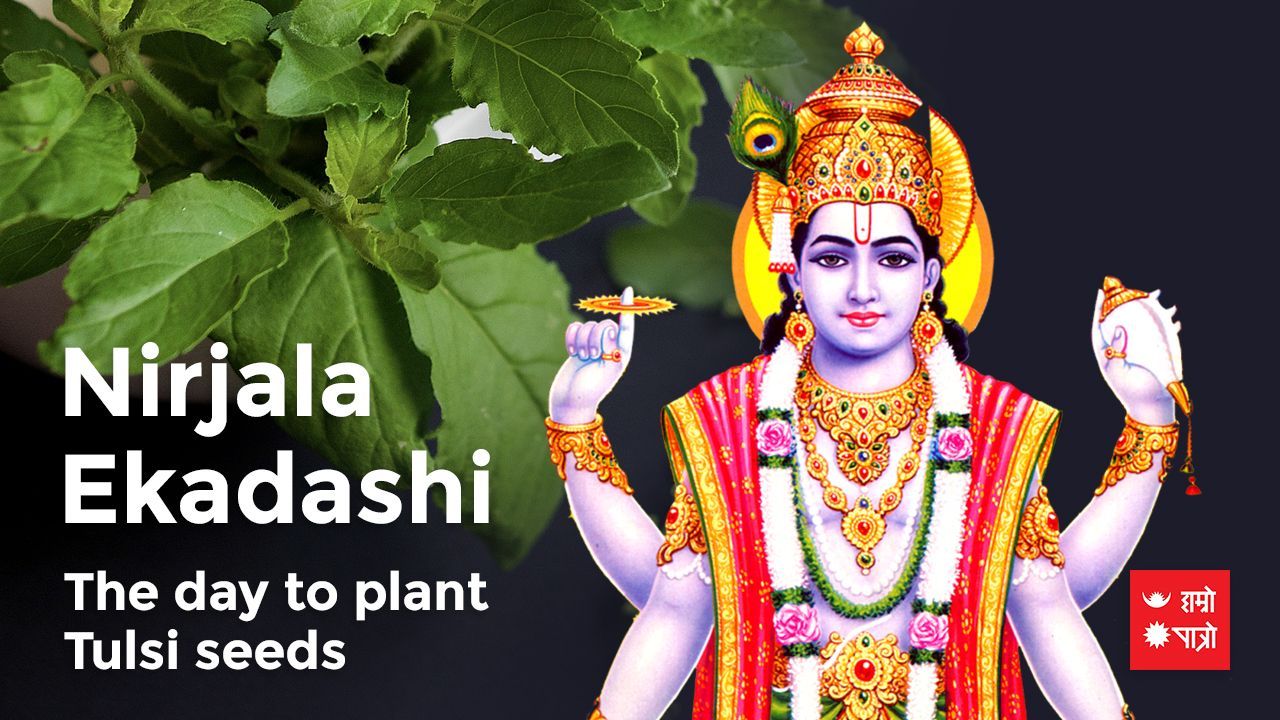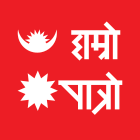Upcomming Events
-
29MangsirSafala Ekadashi Vrata 2 days remaning
-
1PaushDhanu Sankranti 3 days remaning
-
2PaushPradosh Vrata 4 days remaning
-
3PaushInternational Immigrants Day 5 days remaning
-
5PaushTol Lhosar 7 days remaning
-
6PaushWorld Meditation Day 8 days remaning
-
10PaushChristmas 12 days remaning
-
13PaushGorakhkali Puja 15 days remaning
-
15PaushTamu Lhosar/Kavi Siromani Lekhnath Jayanti/Putrada Ekadashi Vrata 17 days remaning
-
17PaushNew Year 2026/Pradosh Vrata/Topi Day/Poshak Day 19 days remaning
-
19PaushSri Swasthani Vrata Katha Prarambha/Maagh Snan/Poornima Vrata 21 days remaning
-
21PaushGuru Gobinda Singh Jayanti 23 days remaning
-
23PaushAraniko Smriti Day 25 days remaning
-
24PaushNepal Astrology Council Establishment Day 26 days remaning
-
27PaushPrithivi Jayanti/Rashtriya Ekata Diwas/Gorakhkali Puja 29 days remaning
-
29PaushNational Bhakka Day 31 days remaning
-
30PaushShattila Ekadashi 32 days remaning
-
1MaghMakar Sankranti/Ghiu chaku khane Din/Uttarayan Arambha 33 days remaning
-
2MaghNational Earthquake Safety Day/Pradosh Vrata 34 days remaning
-
5MaghSonam Lhochhar/Shree Ballav Jayanti 37 days remaning
-
8MaghTilkunda Chauthi 40 days remaning
-
9MaghBasanta Panchami vrata/Saraswati Pooja 41 days remaning
-
10MaghSkanda Sasti/Achala Saptami/International Day of Education 42 days remaning
-
11MaghGorakhkali Puja/World Leprosy Day 43 days remaning
-
12MaghInternational Custom Day 44 days remaning
-
13MaghDron Nawami 45 days remaning
-
15MaghBhima Ekadashi Vrata 47 days remaning
-
16MaghSahid Diwas/Pradosh Vrata 48 days remaning
-
18MaghShree Swasthani Brata Samapti/Poornima Wrata 50 days remaning
-
19MaghWorld Wetlands Day 51 days remaning
-
21MaghWorld Cancer Day 53 days remaning
-
25MaghRavisaptami Vrata 57 days remaning
-
26MaghGorakhkali Puja 58 days remaning
-
28MaghInternational Day of Women and Girls in Science/Safer Internet Day 60 days remaning
-
1FalgunKumbha Sankranti/Bijaya Ekadashi Vrata/World Radio Day 62 days remaning
-
2FalgunShani Pradosh Vrata/Valentine's Day 63 days remaning
-
3FalgunMaha-Shivaratri / Army Day/Silachahre Puja 64 days remaning
-
6FalgunGyalpo Lhosar 67 days remaning
-
7FalgunPrajatantra Diwas / Election Day 68 days remaning
-
8FalgunWorld Day of Social Justice 69 days remaning
Jyotish
-
 Jyotish Mukunda Sharmaस्वाध्याय, सत्सङ्ग र सदाचारजस�...
Jyotish Mukunda Sharmaस्वाध्याय, सत्सङ्ग र सदाचारजस�...
-
Jyotish Damodar Poudelनेपाल संस्कृत विश्व बिद्यालय�...
-
Jyotish Amrit Paudelवाराणसीकै सम्पूर्णानन्द संस्...
-
Jyotish Purushottam Ghimireनेपाल संस्कृत विश्वविद्यालय, �...
-
Jyotish Smarika Acharyaबाल्मीकि बिद्यापिठ बाट ज्योत�...
-
Jyotish Pandit Mukunda Nepalज्योतिष पण्डित मुकुन्द नेपाल�...
-
Jyotish Narayan Prasad Bhandariज्योतिषका उप-प्राध्यापक (lecturer of A...
-
Jyotish Vaman Sapkotaशिक्षा - व्याकरणाचार्य, पौरोही...
-
Jyotish Mohan Ghimireसम्पुर्णानन्द संस्कृत विश्वव...
-
Jyotish Krishna Prasad Bhandariउपप्राध्यापक (Asst. professor of Sanskrit) नेपा�...
-
 Jyotish Dharmendra Krishna Paudelशास्त्री धर्मेन्द्र कृष्ण पौ�...
Jyotish Dharmendra Krishna Paudelशास्त्री धर्मेन्द्र कृष्ण पौ�...
-
Jyotish Dipendra Khatiwadaसम्पुर्णानन्द संस्कृत बिश्वब...
-
Jyotish Narayan Prasad Gautamगुरुकुल शिक्षा प्रणालीबाट ज्�...
-
 Jyotish Kuresh Pandey११ वर्षको अनुभवसहित विभिन्न ध�...
Jyotish Kuresh Pandey११ वर्षको अनुभवसहित विभिन्न ध�...
-
Jyotish Deepak Prasad Kafleसम्पूर्णानन्द संस्कृत विश्वव...
-
Jyotish Damodar Kaushikज्योतिष र व्याकरण विषयमा आचार�...
-
Jyotish Ghanashyam Pokharelनेपाल संस्कृत विश्वविद्यालयब...
-
Jyotish Khageshwor Subediगुरुकुल पद्दति बाट ज्योतिषीय �...
-
Acharya Choodamani Pathakसम्पूर्णानन्दसंस्कृत विश्वव�...
-
Jyotish Dr. Janak Bhattaविगत ३५ वर्षदेखि कुण्डली निर्�...
-
Jyotish Khagendra Subediसम्पूर्णानंद संस्कृत विश्ववि...
Hororscope
Nirjala Ekadashi Vrata

What is Smarta and Vaishnava Dhar?
Smarta
Smarta means householders who worship Hari, Shiva, Shakti, Ganesha and Surya, they do not attach much importance to the rising tithi. All householders who celebrate Janmashtami, Ramnavami, Ekadashi in conjunction with the previous tithi are called Smartas.
"vaishnava"
Those who believe only in Vasudeva, Shri Krishna or Lord Vishnu are called Vaishnavas and all ascetics and sanyasis who hold a Guru also come under the category of Vaishnavas.
In the Vaishnava sect, Udaya Tithi has great importance as Ekadashi is celebrated along with Dwadashi.
Meaning of Vaishnava Ekadashi
When Ekadashi is reflected at the time of local sunrise, it is called Smarta Ekadashi. Vaishnava or Bhagavata Ekadashi occurs when the dashami tithi of any aspect ends on the day of Arunodaya i.e. when the day of Ekadashi ends two hours before sunrise.
That is, Smart Ekadashi ends 96 minutes before sunrise on Ekadashi day. Generally, Vaishnava Ekadashi falls on the day after Smarta Ekadashi.
Nirjala Ekadashi Vrata
पत्रं पुष्पं फलं तोयं यो में भक्त्या प्रयच्छति। तदहं भक्त्युपह्रतमश्रामि प्रयतात्मनस्।।
Krishnarpanam
Lord Krishna himself from the verses of Bhaggwat Geeta, hereby commencing a divine start to today's write-up.
That is to say, I readily accept the fruits, flowers, water, etc., which are devotionally offered with a selfless spirit. In the name of Lord Krishna, we would like to sing the praises of this year's Nirjala Ekadashi, Nirjala i.e. Ekadashi without water, Ekadashi is observed with devotion by fasting without water. Since water is not consumed, there is no question of food or fruits, it is customary for the extremely hungry and pious mind to transmit positive energy and power to the mind and every organ of the body on this Ekadashi. This Ekadashi is also known as Pandava Ekadashi and Bhima Ekadashi.
Vrat Katha of Nirjala Ekadashi
It was customary for five Pandavas and Draupadi to fast on each Ekadashi, but Bhima, who was very fond of food and could not compromise on food, could never break his addiction to food during the fast. Bhima was worried about this and went and told Guru Vyas about this problem. And when Guru Vyas hears Bhima's words, he tells Bhima to fast on Nirjala Ekadashi to get the blessings of the entire 52 Ekadashis at once. Thus this Ekadashi is ritually observed by Bhima, hence this Ekadashi is also called Bhim Ekadashi and Pandava Ekadashi. After the fast of this waterless Ekadashi as Jeshta Shukla Ekadashi, it is customary to get up in the morning on the day of Dwadashi, to be pure and to take food only by giving alms.
What to do ?
Kirtan and hymns of Lord Bishnu have special significance in this Ekadashi. It is customary to donate earthenware pots, hand-made fans made of bamboo, etc. It is customary to perform Sandhya Vandanam one day before Nirjala Ekadashi, devotees keep the holy water pot (Achamuni) in their palm and perform this Sandhya bandana.
Leaving the context of the Mahabharata, Bhima observes this Ekadashi fast with all his food cravings in mind, but the next morning Bhima is found semi-conscious due to hunger and thirst. Then Bhima is raised by giving holy water to Ganga and Tulsipat. This Ekadashi is also the Ekadashi that achieves victory over attachments and desire. May this year's Nirjala Ekadashi be for the welfare of all.
This Ekadashi is specific because the Tulsai seeds are grounded this day, may the sprout behold life, disseminate hope, and prevailing love.
-Suyog Dhakal
Upcomming Events
-
29MangsirSafala Ekadashi Vrata 2 days remaning
-
1PaushDhanu Sankranti 3 days remaning
-
2PaushPradosh Vrata 4 days remaning
-
3PaushInternational Immigrants Day 5 days remaning
-
5PaushTol Lhosar 7 days remaning
-
6PaushWorld Meditation Day 8 days remaning
-
10PaushChristmas 12 days remaning
-
13PaushGorakhkali Puja 15 days remaning
-
15PaushTamu Lhosar/Kavi Siromani Lekhnath Jayanti/Putrada Ekadashi Vrata 17 days remaning
-
17PaushNew Year 2026/Pradosh Vrata/Topi Day/Poshak Day 19 days remaning
-
19PaushSri Swasthani Vrata Katha Prarambha/Maagh Snan/Poornima Vrata 21 days remaning
-
21PaushGuru Gobinda Singh Jayanti 23 days remaning
-
23PaushAraniko Smriti Day 25 days remaning
-
24PaushNepal Astrology Council Establishment Day 26 days remaning
-
27PaushPrithivi Jayanti/Rashtriya Ekata Diwas/Gorakhkali Puja 29 days remaning
-
29PaushNational Bhakka Day 31 days remaning
-
30PaushShattila Ekadashi 32 days remaning
-
1MaghMakar Sankranti/Ghiu chaku khane Din/Uttarayan Arambha 33 days remaning
-
2MaghNational Earthquake Safety Day/Pradosh Vrata 34 days remaning
-
5MaghSonam Lhochhar/Shree Ballav Jayanti 37 days remaning
-
8MaghTilkunda Chauthi 40 days remaning
-
9MaghBasanta Panchami vrata/Saraswati Pooja 41 days remaning
-
10MaghSkanda Sasti/Achala Saptami/International Day of Education 42 days remaning
-
11MaghGorakhkali Puja/World Leprosy Day 43 days remaning
-
12MaghInternational Custom Day 44 days remaning
-
13MaghDron Nawami 45 days remaning
-
15MaghBhima Ekadashi Vrata 47 days remaning
-
16MaghSahid Diwas/Pradosh Vrata 48 days remaning
-
18MaghShree Swasthani Brata Samapti/Poornima Wrata 50 days remaning
-
19MaghWorld Wetlands Day 51 days remaning
-
21MaghWorld Cancer Day 53 days remaning
-
25MaghRavisaptami Vrata 57 days remaning
-
26MaghGorakhkali Puja 58 days remaning
-
28MaghInternational Day of Women and Girls in Science/Safer Internet Day 60 days remaning
-
1FalgunKumbha Sankranti/Bijaya Ekadashi Vrata/World Radio Day 62 days remaning
-
2FalgunShani Pradosh Vrata/Valentine's Day 63 days remaning
-
3FalgunMaha-Shivaratri / Army Day/Silachahre Puja 64 days remaning
-
6FalgunGyalpo Lhosar 67 days remaning
-
7FalgunPrajatantra Diwas / Election Day 68 days remaning
-
8FalgunWorld Day of Social Justice 69 days remaning
Jyotish
-
 Jyotish Mukunda Sharmaस्वाध्याय, सत्सङ्ग र सदाचारजस�...
Jyotish Mukunda Sharmaस्वाध्याय, सत्सङ्ग र सदाचारजस�...
-
Jyotish Damodar Poudelनेपाल संस्कृत विश्व बिद्यालय�...
-
Jyotish Amrit Paudelवाराणसीकै सम्पूर्णानन्द संस्...
-
Jyotish Purushottam Ghimireनेपाल संस्कृत विश्वविद्यालय, �...
-
Jyotish Smarika Acharyaबाल्मीकि बिद्यापिठ बाट ज्योत�...
-
Jyotish Pandit Mukunda Nepalज्योतिष पण्डित मुकुन्द नेपाल�...
-
Jyotish Narayan Prasad Bhandariज्योतिषका उप-प्राध्यापक (lecturer of A...
-
Jyotish Vaman Sapkotaशिक्षा - व्याकरणाचार्य, पौरोही...
-
Jyotish Mohan Ghimireसम्पुर्णानन्द संस्कृत विश्वव...
-
Jyotish Krishna Prasad Bhandariउपप्राध्यापक (Asst. professor of Sanskrit) नेपा�...
-
 Jyotish Dharmendra Krishna Paudelशास्त्री धर्मेन्द्र कृष्ण पौ�...
Jyotish Dharmendra Krishna Paudelशास्त्री धर्मेन्द्र कृष्ण पौ�...
-
Jyotish Dipendra Khatiwadaसम्पुर्णानन्द संस्कृत बिश्वब...
-
Jyotish Narayan Prasad Gautamगुरुकुल शिक्षा प्रणालीबाट ज्�...
-
 Jyotish Kuresh Pandey११ वर्षको अनुभवसहित विभिन्न ध�...
Jyotish Kuresh Pandey११ वर्षको अनुभवसहित विभिन्न ध�...
-
Jyotish Deepak Prasad Kafleसम्पूर्णानन्द संस्कृत विश्वव...
-
Jyotish Damodar Kaushikज्योतिष र व्याकरण विषयमा आचार�...
-
Jyotish Ghanashyam Pokharelनेपाल संस्कृत विश्वविद्यालयब...
-
Jyotish Khageshwor Subediगुरुकुल पद्दति बाट ज्योतिषीय �...
-
Acharya Choodamani Pathakसम्पूर्णानन्दसंस्कृत विश्वव�...
-
Jyotish Dr. Janak Bhattaविगत ३५ वर्षदेखि कुण्डली निर्�...
-
Jyotish Khagendra Subediसम्पूर्णानंद संस्कृत विश्ववि...
Hororscope
Liked by:




















 Mesh
Mesh Brish
Brish Mithun
Mithun Karkat
Karkat  Singha
Singha  Kanya
Kanya Tula
Tula Brischik
Brischik Dhanu
Dhanu  Makar
Makar  Kumbha
Kumbha Meen
Meen